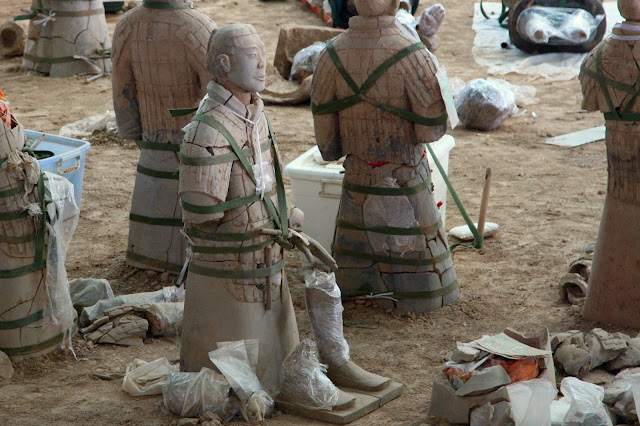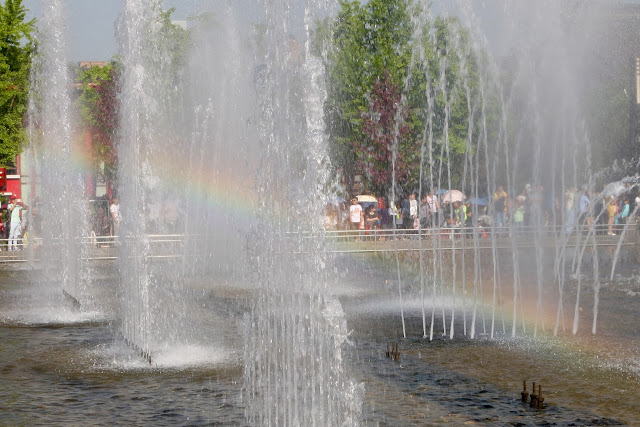I love trips which combine travel and science.* To visit the terracotta warrior exhibit (兵马俑, bīng mǎ yǒng) in Xi'an is to see discovery in action -- both historically and scientifically, ancient and modern.
How did the terracotta warriors come to be? Qin Shi Huang became the first emperor of China in 221BC by conquering six rival kingdoms to unify China under a single bureaucracy. He then standardized the coins, weights, and measures, the writing system, and the legal code. He interlinked the states with canals and roads, and is credited for building the first version of the Great Wall. He planned to rule forever, sending out search parties for an elixir of immortality. In case that failed (
it did. The "elixirs" likely hastened his early death), he planned to rule in death as he had in life, taking all that he might need -- a great necropolis with an army, officers, even acrobats, musicians, and exotic animals -- with him.
Qin Shi Huang began constructing his necropolis when he became emperor. Over 700,000 workers toiled for 11 years to construct the subterranean life-size terracotta army, which was buried with the emperor after his death in 210-209 BC.
And then? The
Qin dynasty was not destined to last long.
Qin Er Shi, the emperor after Qin Shi Huang, ruled as a
puppet for a few short years, a time plagued by internal discord between advisors. He fell in 206 BC to the Han dynasty, which ruled for the next four centuries. The terracotta army, which has silently stood guard over Qin Shi Huang for more than two millenia, were first plundered and desecrated -- some of the figures and ceiling rafters show signs of fire damage; missing weapons were taken to supply real-life armies -- and then forgotten by time.**
In modern times, the existence of the terracotta warriors was unknown; ancient accounts of Qin Shi Huang's tomb make no mention of them. Then, in 1974, fragments were uncovered by farmers digging a well in Lintong district, Xi'an. The terracotta army excavation is considered to be one of the greatest archeological finds of the 20th century. The warrior museum, built shortly after the discovery, now displays the three main excavated pits.
Pit 1 is believed to contain 6,000 warriors; 2,000 are currently on display. At 252 yards long, 68 yards wide, and 16 feet deep, this is the largest pit. One side displays warriors which are largely reconstructed, standing shoulder to shoulder in formation; the other side holds the warrior "hospital", where archeologists work to uncover, preserve, and put together the shattered warriors piece by piece (think Humpty-Dumpty). Spots for thirty-eight horse-driven chariots are scattered through the formation; the terracotta horses remain, marking gaps where wooden chariots once stood.
Pit 2 contains warriors in combat formations that are more complex than Pit 1, including kneeling and standing archers and a chariot war array.
Pit 3 is the command post. Only 68 terracotta figures are present in this grouping, all officials. Interestingly, no commander is present among the officials. It is speculated that Qin Shi Huang would serve as commander, and that no terracotta representation of him could be prepared.
Pit 4, not part of the tour, is reportedly empty -- perhaps unfinished, suggesting that the scale of the necropolis was limited by time and Qin Shi Huang's death rather than his vision.
Accessory pits have also been uncovered in the surrounding area, including three builders' graveyards holding real -- not terracotta -- skeletons. Some of the skeletons show clear stab wounds and signs of hasty burial, indicating that the builders were killed after working on the mausoleum.
There is science at play here -- perhaps more than visitors realize at first glance. The warriors offer some of the greatest insights we have into this period in ancient China and, with science, we can learn about both the processes and the people who created them. The soldiers tell about ancient army formations, in accordance with the ancient directives on the Art of War. The soldiers were originally armed with real weapons -- bronze swords, longbows, arrows, spears, and dagger-axes. Some swords were kept sharp and unrusted for 2000 years by a thin layer of chromium dioxide coating. Modern industrial methods for
chrome plating weren't developed until the 1920s!
An account of the production of the tomb was written by historian Sima Qian one century after the mausoleum's completion. According to his account, 100 flowing rivers in the mausoleum were simulated with mercury; high levels of mercury in the soil give credence to this account. For unknown reasons, the original account makes no mention of the terracotta army.

Production of the terracotta warriors included aspects of mass-production -- heads, arms, legs, and torsos were constructed separately and then assembled. The base structure for each warrior was modified to produce figures that were all unique; final figures were signed by the master craftsmen. Researchers now are using the latest analytical chemistry, scanning electron microscopes, and X-ray techniques to learn more about the production techniques used in the creation of the terracotta army. Each warrior bears different facial features and expressions, giving an indication of appearance at that time. Bones recovered from the builders' graveyards have undergone genetic analysis (
PLoS One,
23andme), showing that workers were conscripted from all parts of China.
Some faces of the terracotta warriors
Much of the terracotta army remains buried, including Qin Shi Huang's tomb; current archeological efforts are purposefully proceeding slowly. They are waiting for a time when technology and preservation methods have improved. Some progress has been made in this regard. The warriors were originally colorfully and realistically painted. Figures bearing this paint have been uncovered, but the color rapidly fades and flakes when exposed to Xi'an's hot, dry atmosphere. As reported in a top chemistry journal, scientists have discovered ways to preserve the paint using, essentially, superglue to affix the lacquer permanently to the terracotta (
Angewante article,
New Scientist). Other studies have revealed the chemical composition of the paints.
Remnants of red and yellow paint
As you exit through the gift shop, you are given the opportunity to buy your own life size terracotta warrior replicas. Qin Shi Huang's army of 8,000 has been multiplied many-fold by modern production. And who knows... maybe that terracotta warrior you buy to stand guard in your home will stand by you in the afterlife!
* When we visited
Kuang Si Waterfall in Laos, for example, I had to find out
why the water was such a striking blue color. Science is everywhere, of course! But we don't always highlight it.
** For another example of forgotten and rediscovered ancient treasures, see
Angkor Wat.



































































